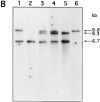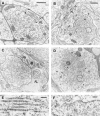Insertional mutation of the Drosophila nuclear lamin Dm0 gene results in defective nuclear envelopes, clustering of nuclear pore complexes, and accumulation of annulate lamellae
- PMID: 9166402
- PMCID: PMC2136230
- DOI: 10.1083/jcb.137.5.1001
Insertional mutation of the Drosophila nuclear lamin Dm0 gene results in defective nuclear envelopes, clustering of nuclear pore complexes, and accumulation of annulate lamellae
Abstract
Nuclear lamins are thought to play an important role in disassembly and reassembly of the nucleus during mitosis. Here, we describe a Drosophila lamin Dm0 mutant resulting from a P element insertion into the first intron of the Dm0 gene. Homozygous mutant animals showed a severe phenotype including retardation in development, reduced viability, sterility, and impaired locomotion. Immunocytochemical and ultrastructural analysis revealed that reduced lamin Dm0 expression caused an enrichment of nuclear pore complexes in cytoplasmic annulate lamellae and in nuclear envelope clusters. In several cells, particularly the densely packed somata of the central nervous system, defective nuclear envelopes were observed in addition. All aspects of the mutant phenotype were rescued upon P element-mediated germline transformation with a lamin Dm0 transgene. These data constitute the first genetic proof that lamins are essential for the structural organization of the cell nucleus.
Figures











References
-
- Aebi U, Cohn JB, Buhle L, Gerace L. The nuclear lamina is a meshwork of intermediate-type filaments. Nature (Lond) 1986;323:560–564. - PubMed
-
- Ashburner, M. 1989. Drosophila. A Laboratory Manual. Cold Spring Harbor Laboratory, Cold Spring Harbor, New York.
Publication types
MeSH terms
Substances
LinkOut - more resources
Full Text Sources
Molecular Biology Databases

